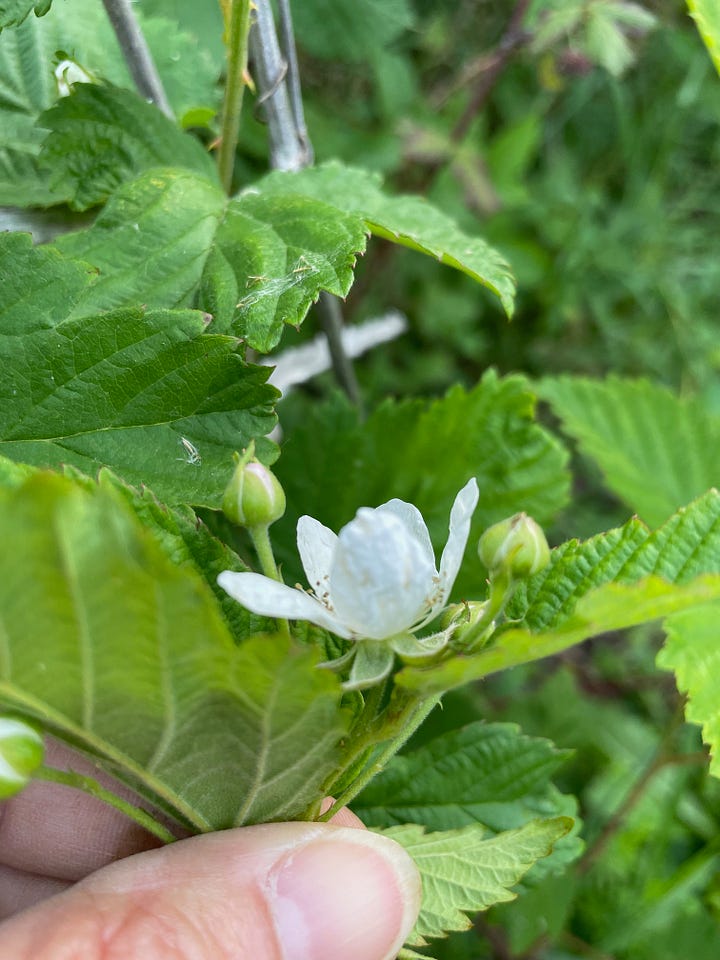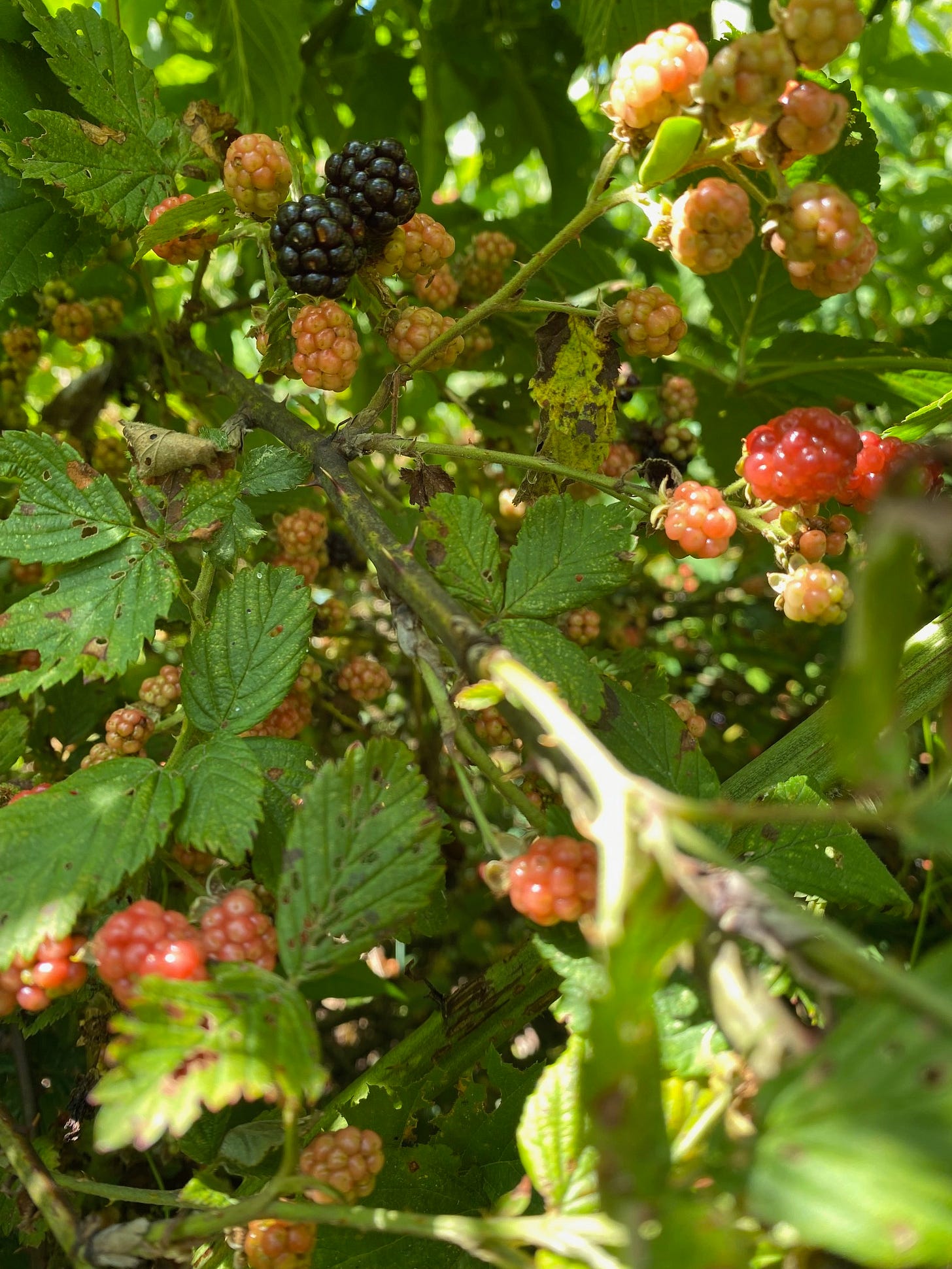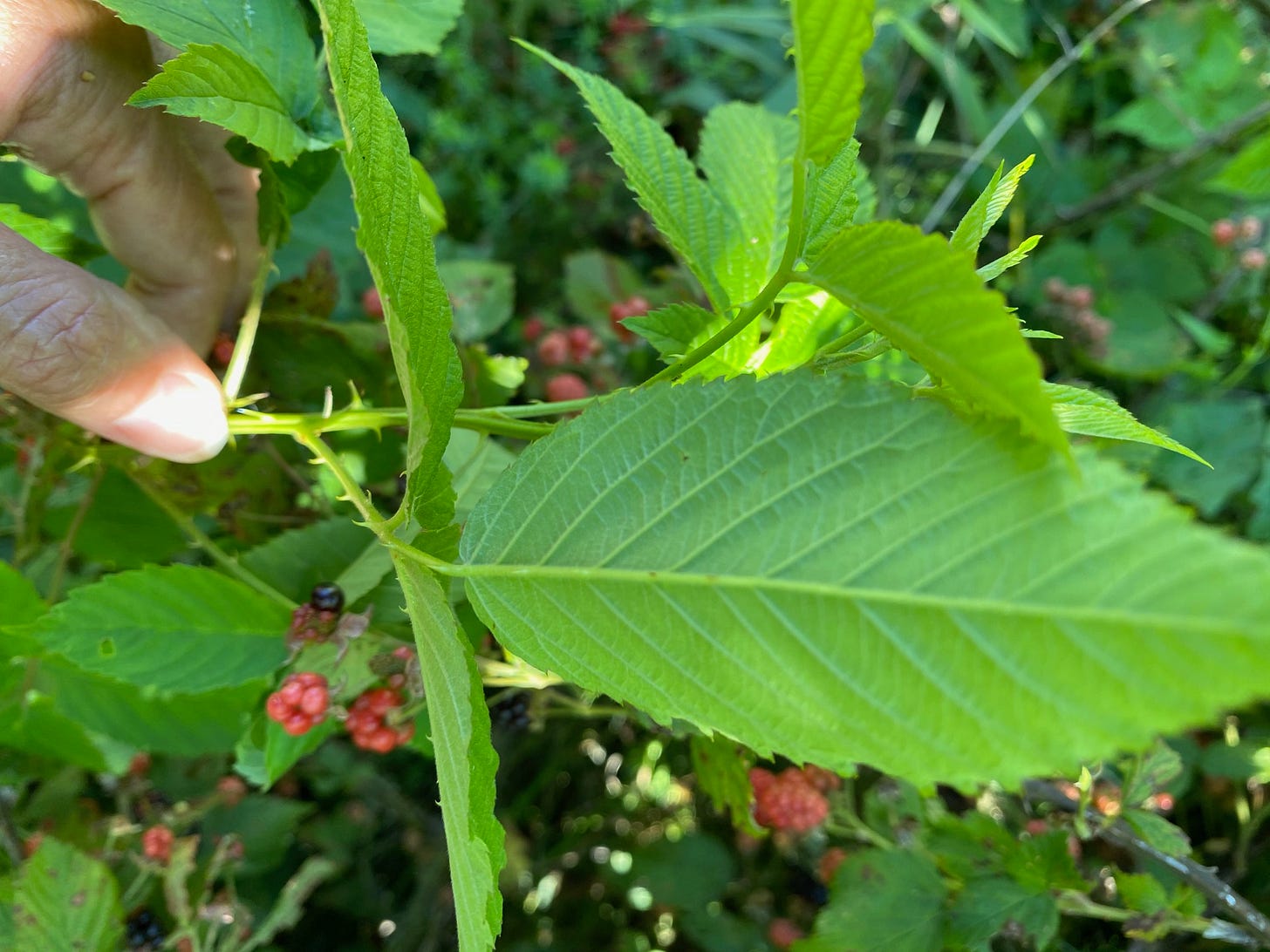We’ve been nutzo for blackberries since childhood. Not those cultivated, thornless varieties, but the crazy wild brambles. The berries wouldn’t taste as sweet without the effort of going into the brush, suffering the prickly assaults on the integument, variable amounts of blood letting, and a criss cross of fine scars on arms and legs by August. Dressing up in long pants and long sleeves seems to bring the chiggers faster, and those leave bites that are far more troublesome than the prickles from the blackberry stems and leaves. The worst aspect of the intensely itchy chigger bites is that they occur most profusely on parts of the anatomy that you can’t scratch in public.
After some seasons of practice it’s possible to get into those blackberry brambles with a minimum of injury, just by wearing a glove on one hand and rearranging a few vines so that you can reach more of the incredible fruits. It’s all about patience. If you want to spare yourself most of the physical cost of obtaining wild blackberries, jump into the shower right after you finish the job. This will save you from most of the chigger and poison ivy consequences. Another way is to cultivate and train your own crop of bushes. So many tamer varieties are available, which can allow you bloodless access to the joys of blackberry harvesting.
July 2024 at weedom is remarkable for blackberry production because we have begun the long work of organizing some of our weeds, and trimmed out the bramble patch that grows next to our mini-swamp. There’s a wild rose bramble remaining, and record breaking productivity of blackberries. Those plants love to be pruned or thinned. The byproduct, blackberry leaves, are a highly respected, traditional herbal medicine that can be collected at any time during the growing season.

The palmate compound leaves of blackberry will help you to know where the wild rose bushes end and the blackberries begin. (The rose bushes have pinnately compound leaves, more like elderberry but smaller.) Blackberry, like the roses, is a member of the family Rosaceae. The blackberry genus is Rubus. The most known species is fruticosus, a.k.a. fruticosa, which is native to Europe and surrounding areas, but an invader to North America. The taxonomy of this plant is crazy as a result of its ability to form seeds without sexual fusion, as well as reproducing by apomyxis through spreading rhizomes. Once in awhile sexual recombination might happen and people will call the result a new species. :-D More than 300 species are recognized by some, and others regard the whole mess as perhaps a few species with numerous varieties. Horticultural pursuits have complicated the taxonomic issue. Almost all of the recognized species are actually agamospecies (clones which reproduce asexually) that are derived from Rubus fruticosa L. However, a blackberry is a blackberry. You will know it when you see the solid clusters of tiny little fruits. Boysenberries and loganberries (which look like dark red blackberries) are hybrid crosses of various blackberries and raspberries.
The serious botanical issue of distinguishing prickles from thorns and spines should be addressed at this time to prevent any confusion. The deep seated thorns are modified branches , and have connection with vascular tissue. They can be quite woody and strong. Spines, formed from external tissues, are modified leaves. Prickles are an extenson of plant cortex, derived from epidermal and sub epidermal tissue They are more easily torn off from a plant, and left in your skin as you pass by. Blackberries have prickles rather than thorns or spines.


Each bloom has 5 petals, 5 sepals and zillions of little pistils emerging from the center, surrounded by numerous tiny anthers. From this flower, the compound fruits, which are technically not true berries, will form. These are actually clusters of tiny little, single seeded fruits called drupelets. As they grow and change from green through white, red then black, they become sweeter and less astringent, until animals, birds and humans eat them. Black rasperries are distinguished from the blackberries by their hollow centers, shaped like a sort of cup built of the tiny fruits.
Blackberry bushes are short lived perennials which vary from upright to trailing vinelike branches. They now reside in every continent except Antarctica. In the first year of life, a plant will produce a primocane, which has only leaves. In the second year, this cane, now a floricane, will produce flowers and fruits and then die off. New primocanes will also be produced which will flower and fruit the following year. For greater fruit production, removing the spent, second year canes, and trimming the primocanes is advised. We did a sort of partial pruning and thinning of our wild plants to get enhanced production this year. (It seems also that the infestation of spotted wing fruitfly, Drosophila suzukii, the recent scourge of blackberries and raspberries, has naturally abated.) A variety of cultivars have different schedules of growth and production. Some can produce flowers on first year canes and again in the second year, and are called everbearing.
It’s good to know how to find free blackberries, particularly in today’s whacky economy. Look at the edges of wooded areas, along old fencerows, and along the sides of creek beds, where no one is spraying herbicides, etc. Blackberries like about 6 hrs of sun per day. Those in zone 5, 6, and maybe 7 are likely to be seeing berries now. They come after the raspberries in late June thru July. Colder areas will see them later. Look for a collection of dead woody canes amid green leafy canes later in the year to locate new foraging spots for next year. Blackberries are a potent source of anthocyanins and ellagic acid, a potent phenolic antioxidant and anti-inflammatory compound, which is also of high interest for anti-diabetic effects. In terms of antioxidant power, these freely available berries can outperform the “superfood” acai and blueberries, all of which have very real potential in protecting against various kinds of tumors. In terms of nutrition, these berries supply numerous vitamins and minerals, but are most prominent as contributors of vitamin C, vitamin K, fiber and sugars. The plus of blackberries is that they can be cleaned and frozen easily for later use or further processing into pies, juice, wine, preserves, etc.
Leaves can be collected from the vegetative branches any time for tea, tincturing and topical use. Tastes are sweet and sour, and this herb is cooling and drying. There is high astringency which has been used to treat diarrhea, and used both topically and internally to slow bleeding of wounds, control the menses and assist with bleeding of gums or G.I. tract. Earliest North American immigrants used the root bark (rich in tannins and saponins) of the related Rubus villosus in the same way as the Europeans used the leaves of Rubus fruticosus. An aqueous infusion of leaf buds in spring were used with honey to address sore throat. Decoctions of root or leaves were used externally to address hemorrhoids, and used in wound care, and to treat psoriasis and eczema. A mouthwash was used to address thrush. Recent studies in rats suggest that the blackberry leaf extracts serve to reduce the tissue damage and memory loss associated with vascular obstruction injury to the brain. Blackberry leaf extracts have been used in Europe to treat diabetes. Studies in rats show that these extracts do exert a hypoglycemic effect.
So there are numerous good reasons for you to find your own blackberries. They’re terrific food, strongly anti-oxidant, and the leaves and roots have shown promising utility as well. At weedom, we’ve been obsessed with the berries for decades, and are more recently collecting and drying the leaves for their medicinal potential. Now is the time for you to get close and personal with this prickly weed to secure its gifts for yourself.
Let us know in chat or comments what you’re doing with your blackberries!
Bonus find at weedom: Big stack of Oyster mushrooms!
Ultra bonus: Here’s #2 reason for the recent interruptions in the weedom publication schedule. We think he’s a really cool excuse, like the first one who appeared six weeks prior. After really messing with his mom during the birth process, he’s been a very peaceful, quiet guy, so far. Just wait till puberty :-D
Though we’ve been significantly distracted by these new guys, and the extra business of summer, we’ll forge on with some new weeds to help you celebrate the season.
Where we dig
1. Wood M. The Earthwise Herbal - A Complete Guide to Old World Medicinal Plants. North Atlantic Books; 2008. https://openlibrary.org/books/OL12031143M/The_Earthwise_Herbal
2. Sung NS, Uhm SH, Kang HB, et al. Rubus fruticosus leaf extract inhibits vascular dementia-induced memory impairment and neuronal loss by attenuating neuroinflammation. Anat Cell Biol. 2023;56(4):494-507. doi:10.5115/acb.23.195
3. Verma R, Gangrade T, Punasiya R, Ghulaxe C. Rubus fruticosus (blackberry) use as an herbal medicine. Pharmacogn Rev. 2014;8(16):101-104. doi:10.4103/0973-7847.134239
4. CABI. Rubus fruticosus (blackberry). CABI Compendium. 2019;CABI Compendium:47995. doi:10.1079/cabicompendium.47995
5. Rubus | North Carolina Extension Gardener Plant Toolbox. Accessed July 10, 2024. https://plants.ces.ncsu.edu/plants/rubus/
6. Ghazaee H, Raouf Sheibani A, Mahdian H, Gholami S, Askari VR, Baradaran Rahimi V. Ellagic acid as potential therapeutic compound for diabetes and its complications: a systematic review from bench to bed. Naunyn Schmiedebergs Arch Pharmacol. Published online July 9, 2024. doi:10.1007/s00210-024-03280-8
7. Blackberry & Raspberry Information | NC State Extension. Accessed July 10, 2024. https://rubus.ces.ncsu.edu/
8. Blackberries for the Home Garden | NC State Extension Publications. Accessed July 10, 2024. https://content.ces.ncsu.edu/blackberries-for-the-home-garden
9. Memete AR, Sărac I, Teusdea AC, Budău R, Bei M, Vicas SI. Bioactive Compounds and Antioxidant Capacity of Several Blackberry (Rubus spp.) Fruits Cultivars Grown in Romania. Horticulturae. 2023;9(5):556. doi:10.3390/horticulturae9050556
10. Peña-Sanhueza D, Inostroza-Blancheteau C, Ribera-Fonseca A, et al. Anthocyanins in Berries and Their Potential Use in Human Health. In: Superfood and Functional Food - The Development of Superfoods and Their Roles as Medicine. IntechOpen; 2017. doi:10.5772/67104











CONGRATULATIONS on the beautiful baby!
Thank you for another beautiful picture of your son!